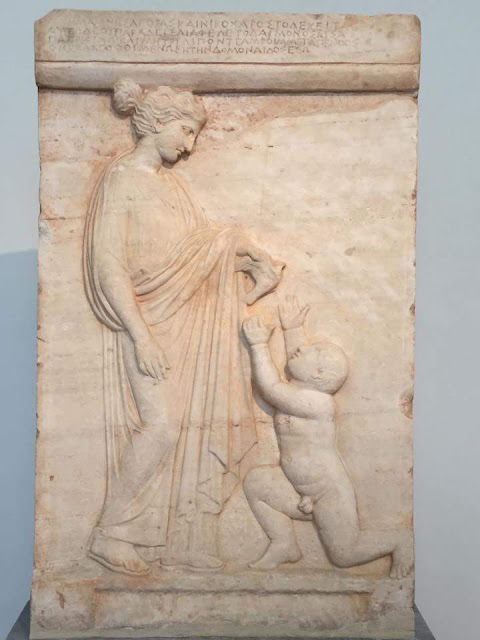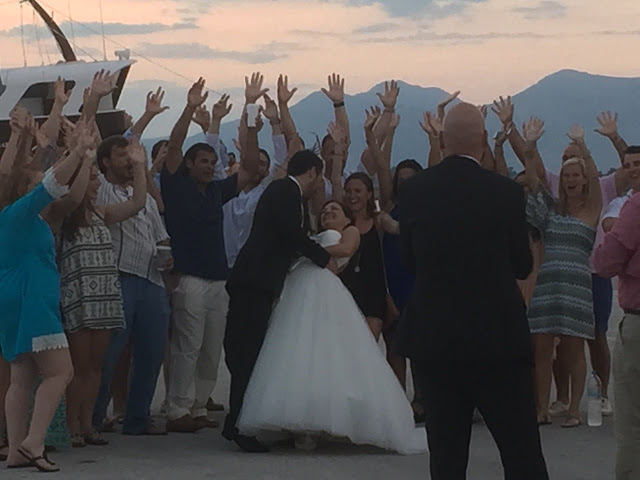For
me, planning for a trip is often more exciting than the actual travel, but this
time it was rather confusing when we decided for our holiday destination to be
Greece. We had ten full days dedicated for the trip; Athens being the historical
treasure remained in the list with five days blocked for a leisurely visit.
Now, we had five days for another place mainly for relaxing midst the exotic Mediterranean
landscape. The islands being the obvious choice for the purpose offered too
many options (Greece has 1400 islands out of which 230 are inhabited). Santorini,
Mykonos and Zakynthos favourite among Indians could have been an easy choice
with exotic location and useful feedback from friends, but beside the charm they
are extremely touristy too. My affinity for a peaceful location with right
blend of nature and city life made me zero down to Napflio after a thorough
research. This Venetian Township, the old capital of modern Greece was
recommended to me by a lot of my Greek friends from Trip Advisor. Its proximity
to Athens (only one and half hour drive) and good bus connectivity was an added
advantage, as Athens International Airport was to be our gateway to Greece.
We
flew to Athens from Kolkata via Doha in Qatar Airways, unfortunately our flight
to Doha (an early morning one) was two hours late, consequently leading us to
miss the scheduled connecting flight and taking the next one from Doha which
was scheduled for five hours later. We had a booking with Taxi Hellas for an
Airport pick up, confirmed through mail. We managed to send another e-mail
stating about the changed flight, though not sure whether the taxi would
actually arrive at the changed time (it was a Napflio based agency). We landed
at Athens finally next day evening, sleepless and haggard, with only a crisp
bed in mind to crash on. None of us had enough courage to take a public
transport to Napflio; we avoided eye contacts with each other while proceeding
towards the arrival gate. A flashy yellow shirt and a placard with ‘PAL’ (our
surname) written on it came into my vision among the cluster of foreign faces.
A robust bearded man with happy face came forward, ‘Pal you are?’ he approached
me, avoiding to pronounce my name (too complicated for him, as his was for me).
‘My name is Vangelis, it means good Angel’, indeed he was one for us. We
started immediately for Napflio taking the Highway, giving the Athens city a
miss to avoid traffic. In a few minutes, misty mountains emerged along the
Highway creating an aura; an instant wellbeing engulfed my tired mind. Vangelis
kept us entertained all through with his witty anecdotes and useful information
enriching our ‘to do’ list. We were amazed by his knowledge not only about his
own country, but also mine and his perspective towards life. On our way he took
us to the historical canal at Karinthos without any additional charge.
 |
| Karinthos canal |
By
the time we approached the old city of Napflio, it was dusk; a glimpse of the
sea and the Venetian houses looked like fairyland in the twilight with its old
world charm. The city with its symmetrical floriated houses along the small
lanes and old-style taverns in between was a reflection of Venice, of her
younger days. We had booking in one of those houses now turned into a guest
house with beautiful interior suited to the antique theme; the manager was a
young lady, vivacious and helpful. Our suite had a balcony with hanging
flower-bed facing a lane adorned with full bloomed Bougainvillea vines, a
traditional Greek tavern was at stone throw distance. We had a quick dinner in
one of those taverns before we hit the bed; a Greek salad with farm fresh
vegetables, feta cheese and amazing homemade red wine was on the menu
(everything was astonishingly cheap in comparison to any other EU country).
 |
| Flower bed in the balcony |
 |
| Glimpse of the township |
 |
| Our balcony view |
 |
| The alleys with taverns |
Our
first day at Napflio started with a hearty breakfast of freshly baked assorted
breads, cakes, homemade jam, honey, fresh fruits and tall glasses of orange
juice; breakfast was served at room only (we gradually realised later, Greek are
hearty people and food has a definite role to play in that). Afterwards we
started for the promenade which was two-three minutes’ walk from the guest
house; an Orthodox Church (Greek are Orthodox Christians) came on our way with
interesting design. It was a bright sunny morning, weather was tolerably warm;
it felt like a dream the moment we reached the Promenade at the seaside. A deep
blue water, crystal clear, almost like a giant swimming pool with mountains
adorning it across the skyline and a pretty castle in the middle; my words
would fall short to describe the trance I was in at the first sight. The
serenity of the quiet township with hardly any tourist even at the promenade
(though plenty of sea-facing restaurants were fully operational) made me feel
like a queen. All through the morning we lazed around the promenade sitting on
benches at different strategic points, even took a walk up the hill alongside
the sea. At some distance across the hill there was a small sandy beach with
few bathers, though we chose not to be among them (the water was cold by our
standard), we satisfied ourselves sitting by a natural pool dipping our feet in
it. We took lunch at a restaurant facing the sea at arm’s length with cool
drinks, salads and some Greek Pizza. It seemed, time stood still at that
vintage town, no was in hurry; one could even sit with a cup of coffee at a
restaurant for eternity, no one would bother. The view of sea was different in
the evening, with more current in the water and the colour even darker, in the
twilight it transformed into a mystique blue; I felt the urge to fall in love
with life afresh. We strolled around the town and its squares after sundown (at
9.30 pm.) with gelato in hand like school children, carefree, livelier than
ever before, hardly speaking any word. A late dinner at a roadside tavern under
candle light with some great local live music added to our boisterous mood.
 |
| The Church |
 |
| Private boats |
 |
| Sea side restaurants |
 |
| From the promenade |
 |
| The promenade |
 |
| A closer look of the castle |
 |
| Hilly walkway parallel to sea |
 |
| The natural pool |
 |
restaurants at promenade
 |
| The city centre |
 |
| Ostrich egg on sale |
 |
| An interesting shop |
 |
| Promenade at dusk |
 |
Twilight view
|
 |
Night is young
 |
| Live music at Tavern |
Next
day as per Vangelis’s advice, we made a half day trip to Mycenae’s Acropolis,
its museum with some wonderful 14th century BC collections and the
treasury of Atreus pertaining to the same era, discretely built at the hollow
of a hill. We also visited the Epidaurus that consisted of a museum, a medicine
centre, a theatre with natural acoustic sound and the temple of Asclepius (the
God of medicine and healing). On our way back it started raining (a rarity in
that region during summer), temperature dropped; the sky took the colour of
dark grey and the sea of greyish blue. We went up to the Palamidi castle at
hill top within the township; it was built by Venetian invaders during their
second occupation and was an Ottoman stronghold during later part of the 400
years of Turkish rule. Finally the freedom of modern Greece was declared from
this castle only in 1822; Napflio became the capital of Greece in 1829 and
remained so for next 5 years, after that Athens became the new capital. The
view from the castle was breath-taking; manoeuvring the steep stony stairs with
an umbrella to be shared by three was breath-taking too. We came down partly
drenched, both by rain and the magnetic charm. The evening, with overcast sky
offered another magical view of the sea; a focus of sudden sunlight sipped through
the cracks of the cloud created an angelic ring on the sea, the blessings of
Almighty could be felt in the vastness.
|
 |
The Acropolis
|
 |
The Acropolis
|
 |
Acropolis museum collections
|


 |
Hidden treasury
|
 |
It's beehive ceiling
|
 |
The Theatre
|
 |
The stage
|
 |
Statues at museum
|
 |
Inscription
|
 |
Palamidi castle
|
 |
view from castle
|
 |
view from castle
|
 |
view from castle
|
 |
view from castle
|
 |
| View from Castle |
 |
| His blessings |
Again the day after we listened to our mascot Vangelis and took a full day cruise from nearby Tolos harbour to the Islands Hydra and Spetses. The description of the landscape during the journey would be very difficult to put in words; hence, I took help of few photographs taken by my novice hand.
|
|
 |
| View from cruise |
 |
| The landscape on the way |
The
island Hydra posed unique because of its ravishing hilltop view; Donkey back
was the only mode of conveyance there, automobiles being banned within the
island. Spetses was a picturesque island township with a promenade, a small
sandy beach, happening pubs and restaurants and a series of beautiful old
fashioned bungalows (extremely well maintained), mostly owned by rich
mainlanders as weekend abode.
The
last day of our stay at Napflio was a Saturday and posed quite a different
picture of the quiet town. Like a sleeping volcano it emerged in life with
sudden vivacity, as visitors from Athens and the nearby villages started
pouring in for a weekend getaway. The Promenade became lively with children’s
laughter, the sea more soulful with enchanted smile of young lovers. We
witnessed the procession of a Greek wedding as it took place in the nearby
Church, the handsome groom kissed his young bride at the Mediterranean backdrop;
Napflio truly stood by its reputation ‘the romantic capital of Greece’.
Like
all other days we (me and my husband) went for a long morning walk for the last
time on the Sunday at the seaside, had coffee at a sea facing restaurant, did
some tit bit shopping from an interesting organic shop and then said goodbye to
the fairyland post breakfast. Our good Angel was ready with his chariot to
escort us to our next destination Athen, the ancient jewel of Greece.















































































































